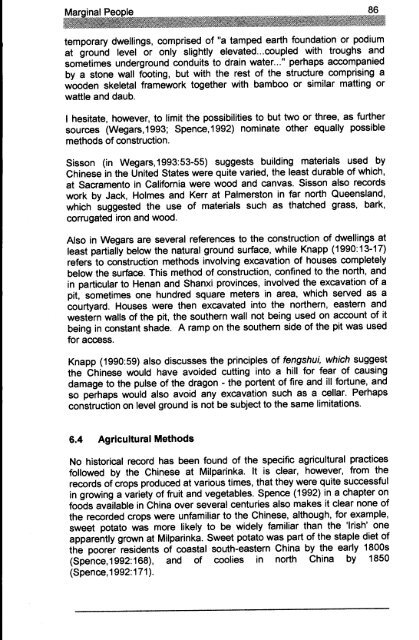Adec Preview Generated PDF File - The Sydney eScholarship ...
Adec Preview Generated PDF File - The Sydney eScholarship ...
Adec Preview Generated PDF File - The Sydney eScholarship ...
Create successful ePaper yourself
Turn your PDF publications into a flip-book with our unique Google optimized e-Paper software.
temporary dwellings, comprised of "a tamped earth foundation or podium<br />
at ground level or only slightly elevated...coupled with troughs and<br />
sometimes underground conduits to drain water. .." perhaps accompanied<br />
by a stone wall footing, but with the rest of the structure comprising a<br />
wooden skeletal framework together with bamboo or similar matting or<br />
wattle and daub.<br />
I hesitate, however, to limit the possibilities to but two or three, as further<br />
sources (Wegars, 1993; Spence,1992) nominate other equally possible<br />
methods of construction.<br />
Sisson (in Wegars,1993:53-55) suggests bUilding materials used by<br />
Chinese in the United States were quite varied, the least durable of which,<br />
at Sacramento in California were wood and canvas. Sisson also records<br />
work by Jack, Holmes and Kerr at Palmerston in far north Queensland,<br />
which suggested the use of materials such as thatched grass, bark,<br />
corrugated iron and wood.<br />
Also in Wegars are several references to the construction of dwellings at<br />
least partially below the natural ground surface, while Knapp (1990: 13-17)<br />
refers to construction methods involving excavation of houses completely<br />
below the surface. This method of construction, confined to the north, and<br />
in particular to Henan and Shanxi provinces, involved the excavation of a<br />
pit, sometimes one hundred square meters in area, which served as a<br />
courtyard. Houses were then excavated into the northern, eastern and<br />
western walls of the pit, the southern wall not being used on account of it<br />
being in constant shade. A ramp on the southern side of the pit was used<br />
for access.<br />
Knapp (1990:59) also discusses the principles of fengshui, which suggest<br />
the Chinese would have avoided cutting into a hill for fear of causing<br />
damage to the pulse of the dragon - the portent of fire and ill fortune, and<br />
so perhaps would also avoid any excavation such as a cellar. Perhaps<br />
construction on level ground is not be subject to the same limitations.<br />
6.4 Agricultural Methods<br />
No historical record has been found of the specific agricultural practices<br />
followed by the Chinese at Milparinka. It is clear, however, from the<br />
records of crops produced at various times, that they were quite successful<br />
in growing a variety of fruit and vegetables. Spence (1992) in a chapter on<br />
foods available in China over several centuries also makes it clear none of<br />
the recorded crops were unfamiliar to the Chinese, although, for example,<br />
sweet potato was more likely to be widely familiar than the 'Irish' one<br />
apparently grown at Milparinka. Sweet potato was part of the staple diet of<br />
the poorer residents of coastal south-eastern China by the early 1800s<br />
(Spence, 1992: 168), and of coolies in north China by 1850<br />
(Spence,1992:171).




